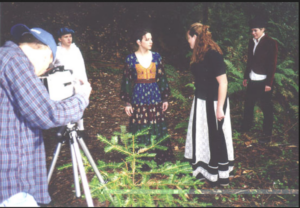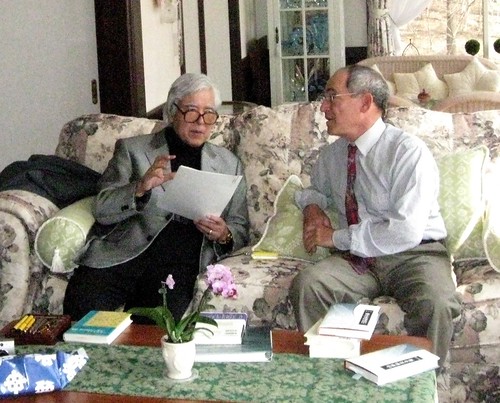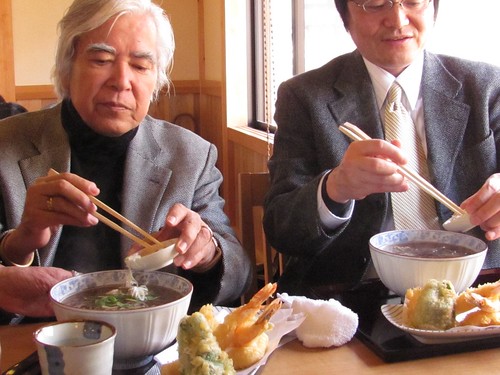Shakespearean Encryptions: Image, Injoke, and Allusion in Ben Elton’s Upstart Crow and All is True
Saturday, November 8th, 2025Abstract
The Droeshut and Chandos portraits, two familiar images, embody two contrasting representations of Shakespeare in Ben Elton’s biofictions, Upstart Crow and All is True.

The Droeshut engraving evokes the comic TV sitcom character played by David Mitchell.
The resemblance is short of literal, belied by the presence of a beard absent in the engraving, but richly suggested by the bulbous forehead and receding hairline, topic of a running gag throughout the series. The actor’s typically bewildered expression conveys what some authorities have found to be a clownish cast in the image. John Dover Wilson called it “a pudding faced effigy.” Northrop Frye said it makes Shakespeare “look like an idiot.”
The Chandos image renders the melancholy film character played by Kenneth Branagh. The resemblance of images here is unmistakable, confirmed by facial hair and costume, by inclusion of the portrait at the opening of the film, and by Branagh’s statements in interviews that this was his intent and inspiration. Nevertheless, the large prosthetic nose and angry eyes convey a much harder expression than the serene watchfulness of the oil painting. The discrepancy prompts the film viewer to collaborate with its producers in fleshing out a dark view of what Shakespeare’s late years in Stratford might have been like.
This essay explores these correspondences in light of encryption theory, an analytical framework derived from computer science, semantics and evolutionary psychology.
Encryption involves “an oblique method of communication” that entails a relationship between the surface content of an utterance and an unstated “implicature,” or key, which is known by both the sender and the receiver, and without which the intended meaning of the message cannot be understood.
In formal encryption, the key resides in a secret code that translates the surface message to the intended one. Formal encryption functions to restrict access to the meaning of messages requiring confidentiality and validate their truthfulness.
Rhetorical encryption encompasses injokes and allusions. The key resides in unstated information shared by members of an in-group and unknown by others. Rhetorical encryption functions to create intimacy and trust among sender and receivers and sensations of pleasure, self-esteem and bonding attendant upon privileged access to information.
In Upstart Crow, the encryption consists of injokes and allusions with distinct but overlapping keys for lowbrow and highbrow audiences of the show. Elton has appealed to both in a genre-crossing-career as standup comedian, actor, director, lyricist, and novelist, employing both crudeness and sophistication.
Upstart Crow often portrays Elton’s fictional writers and actors encrypting injokes and allusions and his fictional audiences enjoying or disdaining them. On this level, it references Shakespeare’s own habit of metatheatrical representation, including staging plays within a play, role-playing, and disguise.
In All is True, the encryption consists of allusions informed by literary and historical scholarship, sympathetic responsiveness to Shakespeare’s texts and subtexts, and an intention to elicit sympathy and tears rather than ridicule and laughter. Consistent with its focus on the poet’s later life, it employs the tragic-comic narrative arc of the last plays and the ironic demand for suspension of disbelief conveyed in its title.
On Oct 31, 2025, at 6:36?AM, Shormishtha Panja <[email protected]> wrote:
Dear Steven
How are you? I hope this finds you well. I heard from Arden Shakespeare (Bloomsbury Publishing) yesterday about the volume Shakespeare/Image for the Arden Shakespeare Intersections Series to which you so generously agreed to contribute an essay. Unfortunately the editors regret that they cannot go forward with the project. I quote from the excerpt of the reviewers’ comments sent by Arden: “It does not engage with recent and current debates… about how cognitive diversity, identity politics or digital technologies are changing how Shakespeare signifies, or is re-presented, as ‘image’ and across visual media….”
The reviewers do appreciate the fact that the volume brings together young scholars and senior ones from all across the globe but that is clearly not enough. I thought that that was the volume’s greatest strength, bringing together academics not just from Spain, Germany, Italy, France, UK and USA but also from China, Japan, Korea, Malaysia, Singapore, Turkey and India. I have not come across such a truly global range of academics and theatre practitioners in any other Arden volume.
I know that you share my disappointment at this outcome. I do hope that you will go ahead and write that fine essay Ben Elton’s Upstart Crow and All is True of which you sent an abstract. I am sure that it will find a home in a journal and an anthology of repute. I learned so much about Shakespeare traditions across the world just by reading your abstract and those of other scholars. It has been a pleasure to interact with you as always, and I am sure that our paths will cross again in the future.
Thank you again for your patience, co-operation and friendship.
Warmly,
Shormi
Shormishtha Panja
Former Professor of English
Department of English
University of Delhi
India











